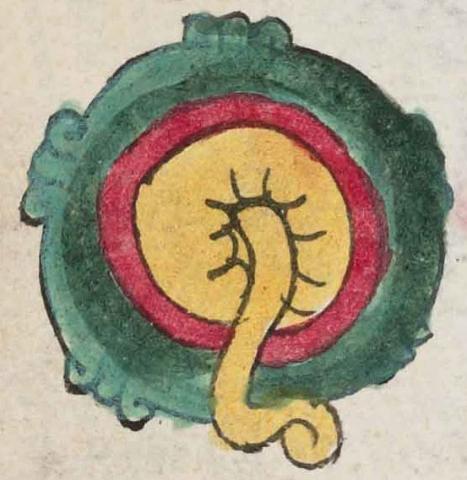Xicco (Mdz20v)
This simplex glyph for the place name Xicco shows an umbilical cord (xictli). The locative suffix (-co) is not shown visually. The navel from which the cord emerges is outlined in green and has rocky outcroppings much like a tepetl (hill/mountain) or an oztotl (cave). Inside the green exterior is a red band, and inside that is the yellow area of the navel.
Stephanie Wood
The umbilical, like other parts of human anatomy, might be lent here to some topographical feature, just as the shoulder might represent a bend in a river or a nose could speak to a peak. The red and yellow recall the slit at the bottom of the tepetl from which water can ooze, as we see in the place name glyph Ixicayan. It is also reminiscent of the top of the arm, at the acolli, when the bone protrudes and from which liquid can escape (see Acolhuacan, below, right). Access to the inner world of the body is reminiscent of access to the underworld, through mountain springs and caves. Note how the caves (oztotl) below have this same red and yellow lining along with the curly outcroppings of rock, like the tepetl. We are restoring to the town name the "c" of the stem "xic-" that got elided with the locative suffix -co in the gloss.
Stephanie Wood
xico. puo
Xicco, pueblo
Stephanie Wood
c. 1541, but by 1553 at the latest
Stephanie Wood
umbilicals, ombligos, navels, belly buttons, caves, mountains, rocks, piedras, cuevas, cerros, nombres de lugares

xic(tli), umbilical cord, navel, https://nahuatl.wired-humanities.org/content/xictli
En El Ombligo
Stephanie Wood
Codex Mendoza, folio 20 verso, https://digital.bodleian.ox.ac.uk/objects/2fea788e-2aa2-4f08-b6d9-648c00..., image 51 of 188.
Original manuscript is held by the Bodleian Libraries, University of Oxford, MS. Arch. Selden. A. 1; used here with the UK Creative Commons, “Attribution-NonCommercial-ShareAlike 3.0 License” (CC-BY-NC-SA 3.0)






